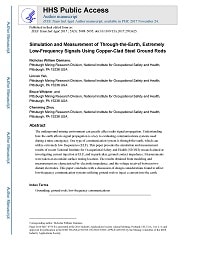Mining Publication: Simulation and Measurement of Through-the-Earth, Extremely Low-Frequency Signals Using Copper-Clad Steel Ground Rods
Original creation date: September 2017
Authors: N Damiano, L Yan, B Whisner, C Zhou
The underground mining environment can greatly affect radio signal propagation. Understanding how the earth affects signal propagation is a key to evaluating communications systems used during a mine emergency. One type of communication system is through-the-earth, which can utilize extremely low frequencies (ELF). This paper presents the simulation and measurement results of recent National Institute for Occupational Safety and Health (NIOSH) research aimed at investigating current injection at ELF, and in particular, ground contact impedance. Measurements were taken at an outside surface testing location. The results obtained from modeling and measurement are characterized by electrode impedance, and the voltage received between two distant electrodes. This paper concludes with a discussion of design considerations found to affect low-frequency communication systems utilizing ground rods to inject a current into the earth.

- Advanced Tutorial on Wireless Communication and Electronic Tracking: Introduction
- Earth Conductivity Estimation from Through-the-Earth Measurements of 94 Coal Mines Using Different Electromagnetic Models
- Magnetic Communication System (MCS)
- Passive Fiber Optic System for Locating, Tracking, and Communicating with Personnel in Coal Mines
- Performance and Safety Investigation of Emergency Backup Batteries and Battery Charging Systems for Underground Mining Applications
- Preliminary Performance Predictions For Electromagnetic Through-The-Earth Mine Communications: A Collection of Working Memoranda
- Through-the-Earth (TTE) Communications: Range Reliability Improvements
- Through-The-Earth Wireless Real-Time Two-Way Voice Communications
- Two-Way, Through-the-Earth Emergency Communication System for Trapped Miners and the Surface
- Ultra-Low Frequency Through-the-Earth Communication Technology